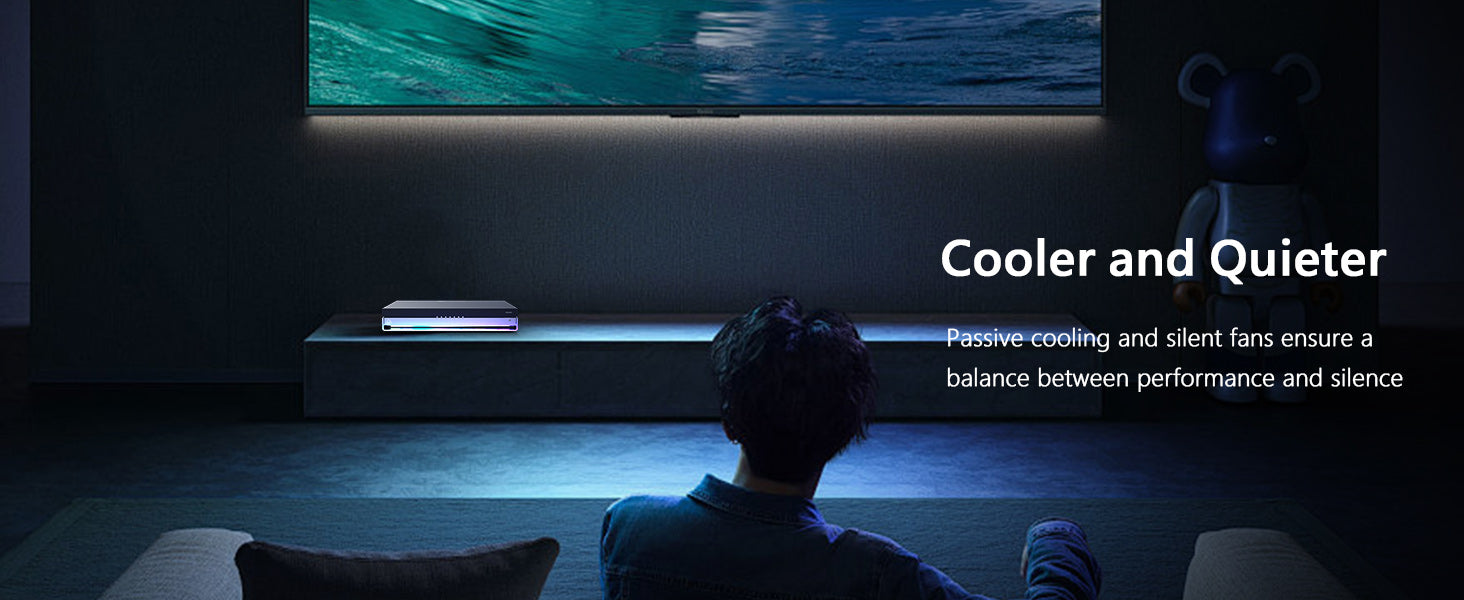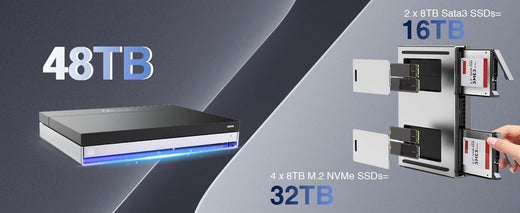Only a few devices offer as much convenience as a Network Attached Storage(NAS) system. Not only does it act as a centralized storage solution but also a valuable addition to your media enjoyment and home theater setup. It lets you store, backup, and access files anywhere in your home. Imagine what more you can do if you choose a NAS with HDMI.
Why HDMI Matters in a NAS
You may wonder why you need a NAS drive with HDMI. Simply put, HDMI turns your NAS into a media player, transforming it from a storage device into a versatile entertainment hub. Here’s a look at some key benefits of NAS HDMI output:
Direct TV Connection
- Simple, Direct Setup: One of the biggest advantages of a NAS drive with HDMI is the ability to connect it directly to your TV. It eliminates the need for a separate media player, allowing you to play videos, display photos, and stream music straight from your NAS device.
- Reduced Lag and Buffering: Unlike network-based streaming, a direct HDMI connection eliminates buffering or quality drops that can occur over Wi-Fi or Ethernet. With NAS HDMI output, you enjoy uninterrupted streaming directly from the NAS to your TV.
Enhanced Home Theater Experience
- High-Quality Streaming: A NAS with an HDMI port allows you to stream media in high definition, preserving video and audio quality. It’s a one-stop media solution, making it a great addition to any home theater setup. It supports 4K or even 8K media streaming with crystal-clear visuals and high-quality audio for an enhanced viewing experience.
- No Network Limitations: Network streaming is convenient, but it can be affected by network congestion. Your stream can be slowed down or interrupted when too many devices are connected to your network. With an HDMI output, your NAS connects directly to your TV, bypassing potential network issues and giving you smooth, uninterrupted viewing.
Flexible Setup Options
A NAS with HDMI offers flexibility that standard NAS systems don’t. Whether you want a minimal setup or a full home theater experience, an HDMI-equipped NAS is what you need:
- Direct Connection: For a simple setup, all you have to do is connect the NAS directly to the TV via HDMI. This is ideal if you’re looking for a straightforward media solution.
- AV Receiver If you have a more advanced home theater setup, connect the NAS to an AV receiver. This makes your NAS a key component in a full-fledged theater experience, allowing you to enjoy surround sound and high-definition video.
- Network Streaming Option: Even if you choose a direct HDMI connection, your NAS can still stream media to other devices in your home over the network, offering maximum flexibility.
What We Should Consider When Choosing a NAS with HDMI
Choosing the best NAS with HDMI requires looking at several factors, each affecting your NAS performance and yourmedia experience.Here’s what you should consider in a NAS with HDMI:
Storage Capacity
- Space for Your Media Collection: The best NAS with HDMI offers ample storage to handle your media library. Think about your collection – if you have lots of movies, photos, and music, you need a NAS that offers high-capacity storage.
- Scalability: Some NAS systems allow you to add more drives as your storage needs grow. If you’re planning to build a large media library, choose a NAS device with the capability to expand storage.
Processor Power
- Smooth Media Playback: One of the most important factors to consideris the processor. A powerful processor allows the NAS to handle media-intensive tasks like transcoding, ensuring smooth playback of your favorite videos.
- Support for Multiple Streams: If you plan to stream content to multiple devices, a high-performance NAS with HDMI will ensure all devices can access content without lag.
Network Connectivity
- Fast Streaming: Faster connectivity translates to smoother playback across all devices. We recommend you get a NAS with gigabit or multi-gigabit Ethernet for seamless network streaming, especially if you’ll be streaming 4K content.
- Future-Proofing: Newer network technologies, such as Wi-Fi 6, provide faster and more reliable connections, so selecting a NAS with HDMI that supports these can future-proof your setup.
HDMI Output Quality
- Check HDMI Version: The HDMI version is useful, especially for higher resolutions like 4K or 8K. It’s importantto ensure your NAS with HDMI port supports a version that matches your TV’s capabilities to get the best results.
- Audio Capabilities: If you’re an audio enthusiast, look for a NAS with HDMI that supports high-definition audio output. You’ll find this particularly beneficial if you plan to connect it to a receiver and enjoy surround sound.
Media Server Capabilities
- Built-In Media Server Software: Some NAS devices with built-in media servers like Plex or Emby, making it easier to manage and stream your media files. These applications offer a more user-friendly way to organize and play back your media on any device.
- Compatibility with Popular Media Solutions: Your NAS should also be compatible with popular media servers. Even if it does not come with a built-in media server, you can choose the software that best meets your needs.
LincPlus NAS with HDMI: A Powerful Choice
If you’re looking for the best NAS with HDMI, you should consider LincPlus. Known for its high-performance, user-friendly NAS solutions, LincPlus combines ample storage and powerful processing, it is a great option for media enthusiasts and home users. It also has an easy setup to enhance your home media experience.
Here’s what makes LincPlus a standout choice in NAS devices:
- High Storage Capacity: LincPlus models come with scalable storage. It gives you the space you need for large media libraries and the flexibility to expand as your collection grows.
- Powerful Processors: Equipped with processors that support HD, LincPlus NAS devices ensure smooth playback and effective transcoding, making them perfect for demanding media applications.
- Intuitive Interface: LincPlus NAS drives with HDMI are designed to be user-friendly, so even if you’re not tech-savvy, you can easily set up, manage, and enjoy their media collection.
How Do I Connect My TV to a LincPlus NAS with HDMI?
Connecting your LincPlus NAS with HDMI to your TV is a straightforward process, and there are multiple ways to set it up, depending on your preferences:
Direct Connection
This option is perfect for those who want a simple, no-fuss connection that gets their media on the screen quickly.Here’s how to do it:
- Connect the NAS directly to the HDMI input on your TV.
- Once connected, select the HDMI input on your TV.
- You’ll see the NAS interface, giving you direct access to your media library.
Receiver Setup
This setup makes the most of a full sound system, turning your living room into a theater experience. It’s simple. If you have an AV receiver, connect the NAS to it instead. The receiver will then connect to the TV, giving you the benefit of enhanced audio, including surround sound.
Network Streaming
If you have multiple screens in your home, you can still benefit from NAS with HDMI. Devices like smart TVs, streaming sticks, or gaming consoles can access your NAS wirelessly. Then, you will stream your NAS content over the network. It is the best of both worlds really, as it gives you flexibility while also allowing a direct HDMI connection for the highest quality viewing experience.
Conclusion
A NAS with HDMI is more than just storage; it’s a powerful addition to any home media setup. Bringing convenience and high-quality media playback to your fingertips, it allows you to enjoy a direct connection to your TV, higher-quality streaming, and flexible setup options.
A NAS HDMI output can cater to different home theater configurations. Think about what you need in a NAS with HDMI storage capacity, processor power, network connectivity, HDMI output quality, and media server compatibility when considering your options So, whether you’re setting up a new home theater or simply want a convenient way to access your media library on your TV, a NAS drive with HDMI could be the perfect upgrade to your entertainment setup!




Commenta
Nota che i commenti devono essere approvati prima di essere pubblicati.
Questo sito è protetto da hCaptcha e applica le Norme sulla privacy e i Termini di servizio di hCaptcha.